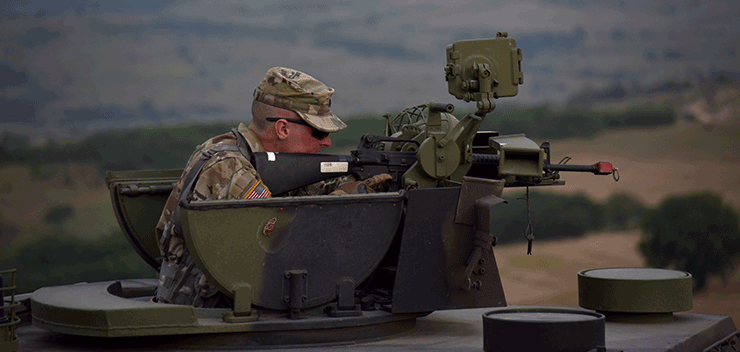
A Soldier assigned to the Ohio National Guard's 838th Military Police Company familiarizes himself with a Serbian military police combat vehicle during the cordon and search portion of Exercise Platinum Wolf 2018.
Training for Peace
Taking place at Serbia’s premier training facility, the Borovac Training Area — located just outside of South Base, in the southern part of the country — the 296-acre training facility supports several specialized training lanes. The soldiers lived and operated from a small tent city, built to simulate a real-world forward operating base, during the exercise.
The exercise, designed specifically to train for peacekeeping operations, focused on four primary tactical areas of training, including military operations in urban terrain; cordon and search; crowd and riot control; and mounted and dismounted patrol. This required the more than 500 soldiers to break down into smaller, integrated groups for the daily scenarios occurring at the various training lanes.
“We gained a valuable opportunity to increase the working relationship with our Ohio National Guard state partners,” said 2nd Lt. Timothy Kurfiss, 838th Military Police Company officer in charge. “We also had the added benefit of getting to train and meet training objectives in a new environment that was not familiar to us. This allowed leaders to plan and execute training for a variety of scenarios and terrains we wouldn’t normally see at home.”
The military operations in urban terrain, or MOUT, training was led by members of the Serbian Armed Forces Special Forces Brigade and taught soldiers to perform police engagement operations; collect police intelligence; process detainees; perform reconnaissance and surveillance; and conduct troop leading procedures.
Cordon and search training supported civil security tactics. Taught by members of Serbia’s 4th Brigade, the training enabled soldiers to conduct police operations including security of critical sites; roadblock and checkpoint security; convoy security and troop leading procedures.
The crowd and riot control training lane also included a portion designated for public law and order with use of nonlethal weapons. This training, taught by Soldiers from the Ohio and Tennessee National Guards in partnership with soldiers from the 4th Army Brigade, allowed soldiers to perform as a response force to conduct security of critical sites, civil disturbance control and troop leading procedures. This area also included host nation police training and support.
Mounted and dismounted patrol lanes focused on reconnaissance and surveillance techniques, police intelligence collection procedures and route regulation enforcement tactics.
Training lanes are used for systematic, performance-oriented training that enables military units to train in smaller teams, quickly and efficiently to attain proficiency in tactics, techniques and procedures. Training lanes are typically built to resemble military operational environments, allowing soldiers to plan, execute and assess training to achieve maximum results.
The use of the training lanes during Platinum Wolf not only allowed for Soldiers from the 838th to work and learn, side-by-side, with their international counterparts, but also played an integral part in ensuring that training aligned with the U.S. Army’s readiness requirements.
The Ohio National Guard Soldiers logged more than 100 training hours and expended more than 5,000 rounds of ammunition, ensuring the company is meeting the goal set by Maj. Gen. John C. Harris Jr., Ohio assistant adjutant general for Army, of being ready to ‘Fight Tonight,’ anytime, anywhere.
“Participation in this multinational peacekeeping exercise has boosted morale and confidence for every Ohio Soldier involved,” Harris said. “The opportunity to operate side-by-side with counterparts from countries such as Hungary, Serbia and the UAE puts an exclamation point on the importance of constant readiness.”
Added U.S. Ambassador to Serbia Kyle Scott: “This exercise is very useful for peacekeeping operations. The most important thing is that our troops train together with other countries’ troops, that they get to know each other’s equipment and that they can train in real time. In real peacekeeping operations, it is usual to have militaries from different countries working together so they need to be able to communicate, to share their equipment and most importantly their operating tactics.” |